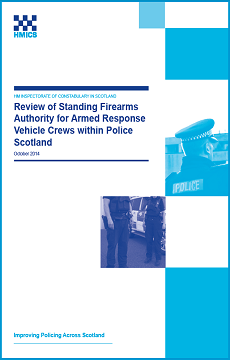The aim of this review is to assess the current practices by Police Scotland in relation to the Standing Authority for the Issue and Carriage of Firearms in terms of the compliance with the relevant guidance, procedures and recognised best practice.
Our assessment has been informed through four key questions:
(a) Was/is the initial and current Standing Authority for Armed Response Vehicles (ARVs) justified by the information and intelligence contained within the Police Scotland Firearms Strategic Threat and Risk Assessment (FSTRA) documents and supporting intelligence products?
(b) What were the reasons leading to the selection of overt carriage of side arms, how does this compare with arrangements elsewhere, and why is this viewed as the most appropriate option by Police Scotland?
(c) What written deployment criteria are in place for Police Scotland ARV officers in respect of both firearms-specific and non-firearms-specific duties?
(d) What external notification and consultation took place around the decision by Police Scotland to deploy ARV officers under the standing authority with overt carriage of side arms?
The Scottish Government set three objectives for police reform:
(i) to protect and improve local services,
(ii) to create more equal access to specialist support and national capacity and,
(iii) to strengthen the connection between police services and communities. In conducting our review, we have taken the opportunity to reflect on the extent to which these reform objectives are being achieved in relation to armed policing.
The full terms of reference for our review and further details of our methodology has been published on our website (http://www.hmics.org/sites/default/files/publications/HMICS%20Terms%20of%20Reference%20for%20Standing%20Firearms%20Authority%20Assurance%20Review.pdf). This complements the parallel scrutiny inquiry by the Scottish Police Authority (SPA) to consider the public impact of Police Scotland’s decisions around firearms deployment.
Number | Recommendation |
|---|---|
1 | Police Scotland and the Scottish Police Authority should engage with the College of Policing to explore options for more formal relationships and reduce the risks and ambiguity which potentially arise from the current voluntary arrangements. |
2 | A member of the Scottish Police Authority should attend future meetings of the Police Scotland Armed Policing Monitoring Group as an observer to improve transparency and provide reassurance to the Authority over any operational decision by the Chief Constable to grant a standing authority. |
3 | Police Scotland should ensure that operational policy decisions around a Standing Authority recorded in the Force FSTRA should have the supporting rationale better reflected in the document. |
4 | Police Scotland should engage with the Scottish Police Authority and relevant stakeholders in relation to its review into the modes of carriage for firearms and ensure that any changes which are likely to have an impact on public confidence are effectively communicated to Local Authorities and communities across Scotland. |
5 | Police Scotland should engage with local stakeholders to develop clear messaging around the limited nature of the standing authority and manage the local community impact from the recent change in operational practice where armed officers may still be seen responding to incidents or requests for assistance. |
6 | Police Scotland should provide clear guidance for ARV officers on how firearms should be handled when they need to leave the ARV when not responding to operational incidents. Where Police Scotland assess that this guidance may have an impact on community confidence, it should be included in any public messaging to communities. |
7 | Police Scotland and the Scottish Police Authority should re-engage with local authorities and other stakeholders and develop criteria for ARV officers to undertake non-firearm duties which are understood and accepted by local communities and allow ARV officers to meaningfully contribute to local policing priorities. |
8 | Police Scotland should adopt a comprehensive stakeholder management process for major policy changes, apply community impact assessments as a matter of course and ensure this is supported by a detailed communications plan. In particular, there should be agreement between Police Scotland and the Scottish Police Authority around how significant national policy changes are communicated in advance. |
9 | The Scottish Police Authority should engage with Police Scotland and other relevant stakeholders to consider the concept of “Operational Responsibility” and develop a shared understanding over roles, responsibilities and boundaries. This should include mechanisms to capture local authority perspectives and apply these within its wider scrutiny and governance of Police Scotland. |
10 | Police Scotland should establish suitable processes to monitor, collate and report against the number of ARV officers and work with the Scottish Police Authority and Police Investigations and Review Commissioner to consider what additional police firearms data can be made publicly available to increase transparency and improve the scrutiny of armed policing in Scotland. |


